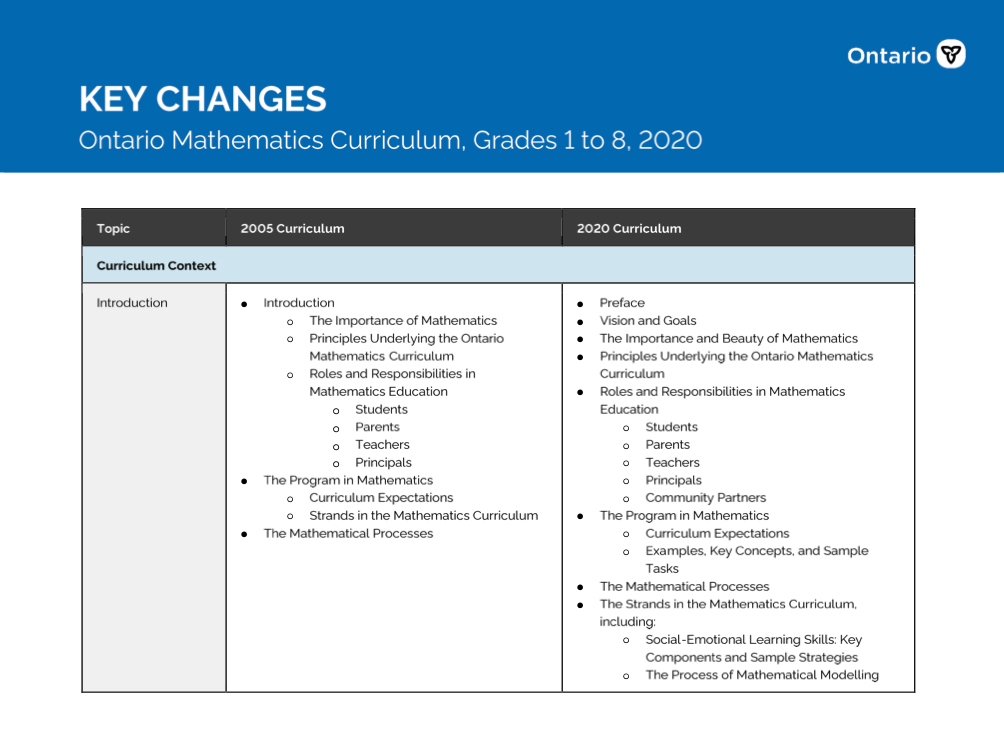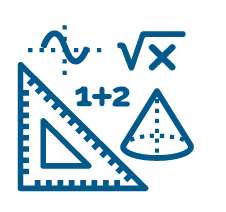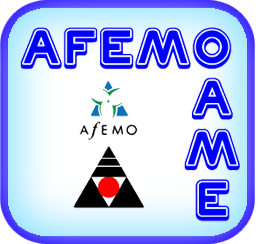Financial Literacy Resources
All 1 2 3 4 5 6 7 8
Overall Lesson Webinar Recording
Select All Clear All
 Key Changes - Ontario Mathematics Curriculum, Grades 1 to 8, 2020
[PDF]
Key Changes - Ontario Mathematics Curriculum, Grades 1 to 8, 2020
[PDF]
This document, prepared by the Ontario Ministry of Education, compares in table form the key changes between the 2005 and the 2020 elementary mathematics curriculum.
 Ontario Mathematics Curriculum, 2020, Grades 1 - 8
[URL]
Ontario Mathematics Curriculum, 2020, Grades 1 - 8
[URL]
This curriculum policy replaces The Ontario Curriculum, Grades 1-8: Mathematics, 2005. Beginning in September 2020, all mathematics programs for Grades 1 to 8 will be based on the expectations outlined in this curriculum policy.
Welcome to this webinar about teaching the new Financial Literacy expectations for the junior grades of the revised mathematics curriculum. In this webinar, we take you through the lessons that have been created by Ontario educators to support Ontario educators. In developing the Financial Literacy lessons for this project, the intentional decision to use scenarios was made. Scenarios give the opportunity to have a discussion about financial choices and the inequities of access to those choices. The goal was to provide students with a chance to learn and understand the individual skills needed that impact personal financial choices and also the economic literacy needed to understand the impact of financial systems as a whole.
Welcome to this webinar about teaching the new Financial Literacy expectations for the primary grades of the revised mathematics curriculum. In this webinar, we take you through the lessons that have been created by Ontario educators to support Ontario educators. In developing the Financial Literacy lessons for this project, the intentional decision to use scenarios-based tasks was made. The goal of the lessons were to provide real-life contexts for students to develop their understanding of money concepts, as an individual and a community.
In this hands-on lesson, students examine the attributes of coins, play games using attributes, create their own coins, and compare the attributes of Canadian coins with students' own imagined coins in so doing, they learn to recognize and describe coins by their attributes e.g., size, shape, colour, image, and texture as well as the value of Candian coins based on their attributes.
I love my name! In this lesson, students will use coin manipulatives to "purchase" the letters in their name in order to make a name plate for themselves. In the process, students learn to compare the value of Canadian coins.
In this lesson students will have to write unplugged codes using a sequence of actions on a 100's carpet or 10 x 10 grid to pick up enough coins that equal 75¢ to buy a marker.
In this lesson, students will calculate amounts of up to $100 for recess equipment.
In this lesson, students will find several ways to represent $ 200 in order to decide what currency they would like to receive from the city for their recycling materials.
In this lesson students will have opportunities to estimate change using coins as well as debug code. It explores financial literacy as well as coding.
In this lesson students work on rounding to the nearest 5 and 10 and make change for amounts under a dollar. It explores how pennies are used in cash and virtual transactions and provides an opportunity to discuss the role of the penny.The Missing Penny is the first of two lessons. The companion lesson, Making Change, is the second lesson in this duo. Making Change is found in the Coding lessons.
This lesson looks at what the word value means and how that relates to money. Students explore whether small change has value. In this lesson, students estimate and find the value of collection of coins and estimate and calculate the change from cash transactions for amounts less than one dollar.
In this lesson, students have an opportunity to apply mathematical modelling to a real life situation that links directly to their science program. Over a period of several months, they will experience the iterative nature of mathematical modelling as they ask questions, engage in scientific explorations and inquiry, collect data, and develop and analyze their models that will be used for an authentic and valuable purpose in the classroom. The potential culminating task - a plant sale - will also give them chances to apply financial literacy skills as well as engage in numerous writing and media opportunities.
Students will create a coding formula in Scratch to find the area of a rectangle so they can paint the walls of the classroom. This lesson addresses multiple expectations in Spatial Sense and Financial Literacy.
Use estimation strategies and operations to determine the best price for bundled items by finding unit rate.
In this lesson, students will think about the factors that influence their decisions when making a purchase. Teachers can explore two scenarios (buying an article that they want and buying an article that they really need). Students will be able to make a decision and justify their choice using factors that can influence spending and saving behaviors.
Students will use a mathematical model to help them determine the best in-game purchases to make in a fictional video game scenario.
Coding using Financial Literacy - In this lesson, students will understand how spreadsheet programs can be used to manage a budget, alter a sample spreadsheet to meet our own plans, and learn to design budgets and make choices based on changing situations (for example by differentiating between needs and wants).
In this lesson, students will begin to think about budgets. Teachers can choose between 2 scenarios (raising money for a trip, or earning money from a job like babysitting) to explore. Students will consider why they may want to earn money, how they might earn it, and prioritize how it might be spent.
In this lesson, students will learn how to estimate and calculate total costs (including HST) and compare that to how much money they have. They will "visit" restaurants to explore estimating and then actually calculate costs given menu items.
In this lesson, students learn to compare prices for different amounts of a product. Many items are sold in packs of various sizes. What is the best price? Are there other factors that influence what you decide to buy? Students learn about various strategies, including finding unit rates, to make financial decisions.
In this lesson, students will code using Google Sheets or any spreadsheet program. Students will be creating a budget to help plan for a financial goal while considering earnings and expenses.
In this lesson, students will be learning to compare different methods of payment--identifying advantages and disadvantages--and the best ways to use them. Students will also analyze and identify how interest rates are applied to various methods of payment in order to make the best financial decision possible when making a purchase.
In this lesson, students will be thinking about ways resources are distributed by means of donating, exchanging, lending, and borrowing through the creation of a community project.
In this lesson, students will be identifying types of financial goals and how to achieve them, as well as describing factors that help or interfere with reaching them. Students will then continue working towards the lesson learning goals using a project-based approach--preparing and presenting a convincing argument for how they will be able to reach their fundraising goal.
In this coding lesson using Scratch, students can create a calculator in which they can compare two different discount structures. Depending on the number of items bought, the calculator will be able to provide savings from either choosing a 20% discount, or a $ 20 discount. Students get to utilise conditions and operations blocs in this activity.
In this lesson, students will learn about the value of creating a budget, different types of savings accounts and the implications interest rates can have on saving money. Following that, students will use money earned from a part-time job and saved over time to investigate various mobile phone plans to determine which one best suits their needs.
In this lesson, play money is used to simulate the experience of exchanging currencies. Students will learn how to perform currency exchange, why it exists and they will learn how to use online currency exchange rate websites.
In this lesson, students will analyse different scenarios in order to identify the factors that influence financial decision-making. Students will evaluate the impact of each factor on the decision-making process and how they effect short and long term financial goals.
In this lesson, student will investigate different aspects of how interest is calculated, charged and earned. Students will compare scenarios to understand the impact of interest.
This lesson is an introduction to credit cards. Students will learn about the benefits and disadvantages of using credit cards by comparing interest rates, annual fees, rewards and other incentives.
In this lesson, the student learns how to make and maintain a balanced budget using various budgeting tools.











































